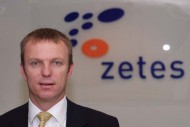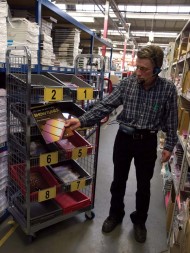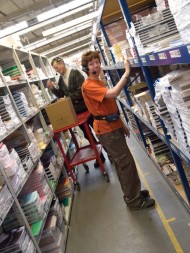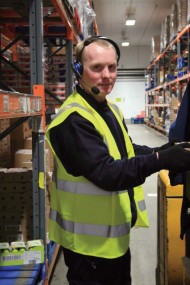 The current tough business climate is showing no real sign of abating and the supply chain is continuing to be regarded as an ideal target for further optimisation and cost reduction.
The current tough business climate is showing no real sign of abating and the supply chain is continuing to be regarded as an ideal target for further optimisation and cost reduction.
Voice-directed picking offers an ideal route to greater working efficiency and operational agility, but few voice providers are as well equipped as Zetes to help companies implement the technology and reap its benefits.
Established in 1984, and with total 2008 sales of €177.6m, Zetes has become Europe’s foremost provider of voice solutions. The company employs 800 staff based across 13 countries, and last year implemented 60% of all voice projects in Europe. According to Zetes’ own estimates, they have now completed 800 voice projects, supporting over 40,000 users. Here in Britain, two of the UK’s biggest third party logistics providers, two out of the top five UK supermarket chains and a host of manufacturing companies are among the corporate customers using Zetes’ voice solutions to increase their warehouse efficiencies, and adoption rates are accelerating.
 A key figure behind Zetes’ continuing success with voice and other technologies is James Hannay, recently promoted to Senior Vice President for Northern Europe. James originally joined Peak Technologies 12 years ago as Sales & Operations Director, and was appointed as Zetes’ UK Managing Director in 2007 after Zetes acquired Peak. In his current role, James’ remit covers the UK, Ireland and the Nordic countries. He explains his vision for the Northern Europe region and goal to strengthen Zetes’ reputation as an integrator and solution provider specialising in supply chain optimisation.
A key figure behind Zetes’ continuing success with voice and other technologies is James Hannay, recently promoted to Senior Vice President for Northern Europe. James originally joined Peak Technologies 12 years ago as Sales & Operations Director, and was appointed as Zetes’ UK Managing Director in 2007 after Zetes acquired Peak. In his current role, James’ remit covers the UK, Ireland and the Nordic countries. He explains his vision for the Northern Europe region and goal to strengthen Zetes’ reputation as an integrator and solution provider specialising in supply chain optimisation.
“Although I manage a large operation, it is important that I get personally involved with clients during the projects, during which we help customers understand both their business issues and how our competencies can help address these challenges. I believe it’s very important for senior management in a company like ours to have strong relationships with customers, and we place a great deal of emphasis on developing a partnership approach in the work we do.”
Whilst there are plenty of device suppliers out there, Zetes is unique as a system integrator for the entire supply chain, serving manufacturing, warehouses, delivery and retail store operations. Similarly unique is their approach to creating technology solutions. “We are ‘technology-agnostic,’” James points out, “so are not aligned to any particular hardware or software vendor, and give an objective view in our recommendations for solutions. We’re noticing more customers want to avoid lock in to particular device manufacturers, and openness and integration are increasingly important factors during the decision making process.”
 Although voice is a major part of Zetes’ business, as James points out it’s not the company’s only area of expertise. They also supply integration solutions and applications for many other areas within the supply chain using wireless and goods identification technologies. In their manufacturing solutions they deploy mobile hand-held devices, so raw materials and components can be scanned off the production line onto pallets and into the warehouse, with voice, RFID and hand-held devices, and from the warehouse to the end point with ePOD.
Although voice is a major part of Zetes’ business, as James points out it’s not the company’s only area of expertise. They also supply integration solutions and applications for many other areas within the supply chain using wireless and goods identification technologies. In their manufacturing solutions they deploy mobile hand-held devices, so raw materials and components can be scanned off the production line onto pallets and into the warehouse, with voice, RFID and hand-held devices, and from the warehouse to the end point with ePOD.
As an experienced integrator of all these technologies, Zetes has developed specialist software to enhance the functionality of the hardware it deploys. 3iV Crystal is its latest innovation, launched over a year ago: “The recent convergence of technologies in the market has led us to adapt our software applications to avoid having to complete heavy customisation for the different hardware platforms available. That’s why we launched 3iV Crystal as a ‘best of breed’ solution based on our experience. It’s a proven software application, and as manufacturers continue to introduce new hardware, it offers the customer the flexibility of a completely open, hardware agnostic system, with a clear technology roadmap.”
Zetes’ innovation is driven from the company’s 3i Competency Centre in Belgium, headed by Marcel Kars. “Marcel and his team identify new ways to use proven technologies and create new applications, which are then rolled out to individual markets,” says James. “For instance, Marcel’s team were very early to identify the benefits of combining voice and RFID to achieve almost 100% accuracy levels, which for certain applications is very important.”
Voice – a compelling proposition
Voice directed picking is suitable for any operation where people want to improve operational efficiency and reduce errors. In the present climate the business case for voice is very compelling, as James Hannay explains: “Bar codes deliver 95-96% accuracy, but voice delivers over 99%. Introducing voice into the big retailers, we are seeing increases in picking accuracy from 99.8% to 99.99% levels. This translates into possible productivity improvements of 15-30%, depending upon the level at which they started.
“When voice was initially introduced, people still regarded bar code technology as being central to eliminating errors. But voice actually delivers even greater accuracy and it also makes it much easier to manage picking operations. It’s human nature to respond to commands as you’re looking in front of you, and so it’s difficult to make mistakes. Working with barcodes and hand held scanners is a less natural way of working because it requires looking at a list and then moving around to locate the items – there’s a gap between command and task,” explains James.
“Fast moving pick faces are the sweet spot for voice,” he continues. He describes conveyor systems with a pick face on either side, with people running around in shorts and trainers who receive bonuses on volume of picks they achieve per hour. “Voice gives more flexibility in the warehouse: you can zone different speed products in different areas. Enterprises considering shifting to automated conveying systems can go straight to voice picking.”
 A prospective migration to voice needs very careful evaluation, according to Zetes. “It’s vital for companies considering buying a voice solution to understand the extent of the change they would be introducing,” says James. But thanks to an increased level of understanding, a growing number of organisations are becoming ready to consider adoption. “There’s good awareness of voice among senior management: all our conversations at senior level are financially driven. Every customer is different, but most companies see a return on their investment in six to nine months, and companies that need to improve their efficiency generally will do even better.”
A prospective migration to voice needs very careful evaluation, according to Zetes. “It’s vital for companies considering buying a voice solution to understand the extent of the change they would be introducing,” says James. But thanks to an increased level of understanding, a growing number of organisations are becoming ready to consider adoption. “There’s good awareness of voice among senior management: all our conversations at senior level are financially driven. Every customer is different, but most companies see a return on their investment in six to nine months, and companies that need to improve their efficiency generally will do even better.”
Such strong financial incentives have enabled Zetes to secure some very significant UK voice contracts in the last 18 months. James explains the rationale for this: “Possibly because of the very bad economic climate, particularly in the UK, companies are now very aware of voice’s fast ROI and its benefits over and above the conventional combination of handheld devices and paper picking.
For example, Morrisons invested over £6m in voice picking across all their DCs, and the Co-op has also extended voice picking to six of its DCs. Another of our clients is putting voice into its retail stores to speed put away and clear bottlenecks at the back of the store.” This in-store project marks the first time a retailer has used voice in this way in Europe and it represents a big new opportunity for customers. “Various other new clients are in the selection process for active solutions currently, with eight to ten at decision stage – the market is very buoyant.”
Elsewhere in Continental Europe, where voice has been in mainstream use for many years, Zetes’ mature customers in the supermarket sector include Carrefour, Metro and Auchan. The company also works with Nike in the Netherlands, at the ‘highest tech’ distribution centre in Europe. In the Nordic countries, Zetes has implemented a multi-modal solution for Volvo in Sweden with full voice and screen capability. Volvo is using their application on the assembly line to enhance their manufacturing process. Being multi-modal, the same equipment is used to process goods in and out – workers can log in and respond to a menu choice of applications, which supports much more flexible warehouse resourcing.
Although the majority of adopters to date have been enterprise users such as Morrisons, voice is an equally viable technology for SME’s such as Faber Music Distribution to adopt. Faber employs 8 pickers in their publication warehouse and realised the same benefits from switching to voice immediately upon implementation. Zetes also has UK clients in ‘pure’ logistics, as James continues, “Some 3PLs here are using voice as part of projects which have been partly ‘sponsored’ by their clients under service agreements.”
As James makes clear, one of voice’s big attractions is that it is very easy to work with and training is minimal – new workers can be fully functional in less than four hours. In addition, voice gives access to a multilingual workforce who can work in their native tongues. The administrator asks the user to read a list of commands in English to log on, and working with the headset each individual can reply in his or her preferred language. “Languages are one of the easiest things to change. Users don’t need to speak English fluently but simply understand around 30 words and the numbers from one to nine.”
Reducing errors mean increased returns
“When you work with Zetes, what you are buying is not so much functionality, although that is also a factor, but experience and approach,” continues James. “As the market leader, we have more installation and integration experience than anyone else. The key to being able to offer users the flexibility of multi-modal solutions is our 3iV Crystal application, which works with handheld scanners, fixed scanners or voice picking, multi-modal or as directed.”
Zetes’ approach to projects starts with examining a customer’s current processes and warehouse functions. After the analysis phase, the team presents an end-to-end solution, secures client commitment and then conducts a workshop with the client to agree how the solution will work.
“Our approach is driven operationally and we help customers to secure buy-in for their projects from right across their organisations,” says James, “In practice this means ensuring that everyone from the operations director down to the staff champions participates in the workshops to agree new processes which suit voice directed working.” The infrastructure implications and sheer volume of data mean the IT team must also be involved. Finally, the management applications people need to have their say too.
“From there we design the specification and implement the project – deployment, pre-configuring the software, installing the hardware, user training and ‘go live.’ Once the solution is live we offer full support from a single help desk and on site support for all issues.”
“It’s important not to start with pre-set views of what a client should do,” says James. “With individual customers, we reach the point whereby we advise that either handhelds or voice is the most suitable technology, or suggest different technology to be deployed for different parts of the warehouse process. For instance, if people spend time walking between sections, it is important to think about automating and relaying the warehouse. We also advise changes at a ‘micro’ level: so, for an aviation customer, we recommended putting three different types of small components into one drawer, and this tripled their storage space. On a larger scale we advise on laying out shelving and product location.”
“Our solutions are highly scalable, dependent upon the customer’s infrastructure. Provided that the servers and the Wide Area communications are adequate, voice will work. As part of the consultancy phase, we will conduct site surveys and provide advice on network specifications.”
Zetes regularly takes interested companies to visit customers’ operations to see their various solutions in action, and are holding a ‘technology in context’ day with Superdrug (AS Watson) in Dunstable on 10 June, in conjunction with Cranfield University and their Agile Supply Chain Group.
“We are very proactive about communicating as an organisation, and run a number of events and seminars to help build awareness of the potential offered by different technologies. We also hold thought leadership events and like to bring our users together in communities to share best practice, usually at our bigger customer sites.”
Finally, when asked for his predictions regarding voice adoption, James concludes, “In Continental Europe, voice adoption began in food and apparel, before spreading into different areas, including automotive and aviation. We expect the same trend to happen here in the UK. Voice is the technology of the moment, but it is a complex business ‘sell’ and needs proper consultation. If implemented incorrectly the benefits will not be realised, but equally, a successful implementation will bring about a total transformation, and we have all the skills and expertise to help customers achieve this.”
Zetes Northern Europe tel: 01344 290000 www.zetes.co.uk




Comments are closed.